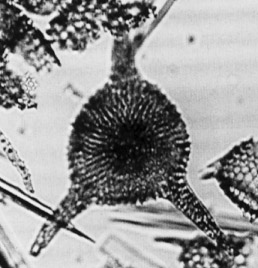 Lithocyclia
angusta (Riedel)
Lithocyclia
angusta (Riedel) Lithocyclia
angusta (Riedel)
Lithocyclia
angusta (Riedel)Trigonactura ? angusta Riedel, 1959, p.292, pl.1, fig.6
Lithocyclia angustum (Riedel), Riedel and Sanfilippo, 1970, p.522, pl.13, figs.1-2
Phacoid cortical shell approximately three times as broad as the medullary shell (when the latter is distinct), with eight to eleven subcircular to circular pores on its radius. Cortical shell in some specimens filled with spongy meshwork. Three arms not strictly chambered, but rather subcylindrical spongy columns, broader at the base and tapered distally. In rare specimens a spongy patagium, its outline parallel to that of the cortical shell, connects the bases of the arms (Riedel, 1959).
Based on 20 specimens. Diameter of cortical shell 108-145 µm; of medullary shell (shadowy outline seen through cortical shell) 35-50 µm. Length of arms 85-158 µm; median breadth 18-28 µm (Riedel, 1959).
Diameter of cortical shell 110-150 µm (to 185 µm in DSDP 78-24-1), width of arms medially 15-35 µm (usually 20-25 µm) (Sanfilippo et al., 1985).
From the margin of the discoidal cortical shell arise three narrow spongy arms (forms with four arms being separated as L. crux Moore) (Riedel and Sanfilippo, 1978a).
L. angusta is distinguished from L. crux by having three spongy arms rather than four, and from L. aristotelis by the arms being narrower. When the arms are reduced to only spines, the species closely resembles Periphaena tripyramis (Haeckel, 1887), but that is an early to middle Eocene species with rather smaller pores on the cortical shell (Sanfilippo et al., 1985).
In early specimens the phacoid cortical shell is circular and the three spongy arms are of almost equal width throughout, while in late specimens the cortical shell tends to be slightly triangular and the arms are shorter, tapering, and merge into a solid terminal spine (reduced to only a spine in DSDP 78-24-1). The surface of the cortical shell is irregular, almost spongy, in some early specimens, but is a more regularly latticed lamella in late ones (Sanfilippo et al., 1985).
This species is found in practically all tropical assemblages of Oligocene age. The evolutionary transition of this species from the Lithocyclia aristotelis group defines the base of the Theocyrtis tuberosa Zone. Its morphotypic last appearance lies within the Dorcadospyris ateuchus Zone.
This species developed from the Lithocyclia aristotelis group, and it (or L. crux) evolved into Didymocyrtis prismatica.